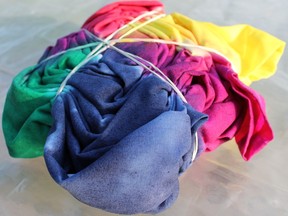The 20 million people who visited the 1904 fair left with some food for the mind as well as with novel foods in their belly.

Let’s drop in for a visit to the Palace of Agriculture at the 1904 St. Louis World’s Fair. That’s the one immortalized in the song Meet Me in St. Louis, written for the opening of the fair and made famous 40 years later by Judy Garland in the classic film with the same title.
There was no singing at the Pure Food Exhibit in the Palace, but there was a lot of gasping by onlookers who were watching a piece of white flannel being dyed pink. Why the gasping? Because in front of their eyes, the dye had been extracted from a common food. Ketchup! The demonstrator explained that this was a “poisonous aniline dye,” used to make pumpkin pulp look like tomato ketchup. When the same extraction method was applied to a sample of authentic ketchup, there was no dye to be seen.
More eyebrows were raised when the crowd was shown a bottle labeled as “pure lemon extract” that contained no lemon oil. Instead, it contained toxic wood alcohol (methanol) coloured yellow with an aniline dye. Then a sample of cayenne pepper turned out to be ground nut shells dyed red. Aniline dyes made another appearance in “strawberry jam” that was nothing but macerated pumpkin mixed with timothy seed.
The goal of the startling demonstrations was to alert the public to some of the nefarious food adulterations used at the time to boost profits. Aniline dyes, often referred to as “coal tar dyes” in reference to the source of the aniline, sounded particularly dreadful and had never been tested for safety in food. Alarm was further raised when Upton Sinclair’s iconic book The Jungle revealed the horrors of the meat-packing industry. Sinclair described how packers would battle rat infestations by putting out poisoned bread. Then the dead rats, bread and meat would go into the hopper that ground the mass into sausages. The Jungle and the Pure Food Exhibit laid the foundation for the 1906 Pure Food and Drug Act, the first law in the U.S. to address the problem of food adulteration.
Fair-goers who had watched the distressing demonstrations at the Palace of Agriculture were likely to cast a wary eye on the foods sold by the many concessions that lined the Pike, the Fair’s major thoroughfare. Particularly the sausages. As the story goes, German immigrant Antoine Feuchtwanger was selling hot sausages from his booth and handing out white gloves to his customers to prevent their hands from getting greasy. He ran out of gloves and, as luck would have it, a vendor next to him was selling waffles. Feuchtwanger had a brainstorm, wrapping his sausages in those waffles and the “hot dog” was born. Intriguing story, but almost certainly apocryphal. There are accounts of British immigrant Harry Stevens selling sausages in French rolls at the Polo Grounds in New York well before 1904 and supposedly Charles Feltman wrapped his sausages in pie dough on Coney Island in the late 1800s.
A better case can be made for ice-cream cones being invented at the fair. Ice cream was already well known and was sold at a booth in paper cups until the vendor, Arnold Fornachou, ran out of cups. Luckily nearby was a waffle maker, usually identified as Ernest Hamwi, a Syrian immigrant. Another brainstorm: Fornachou twisted a waffle into a cone, plunked a scoop of ice cream on top and gave birth to the ice-cream cone. A famous picture taken at the fair shows three children licking ice cream from what look like waffle cones.
Other accounts claim that cotton candy, peanut butter and Dr Pepper were also introduced at the St. Louis Fair. While they were certainly popularized there, all had been produced and sold before 1904. William Morrison and John Morton had patented a machine that melted sugar in a spinner and forced it through tiny holes into streamers that froze on contact with the cooler air and turned into what they called “fairy floss.” Morrison benefited in more than one way from the invention, since he was a dentist.
The peanut butter that tantalized palates at the fair was produced by a machine that ground peanuts into a paste, patented a year earlier by Dr. Ambrose Straub. He came up with the idea to provide protein to his many patients whose rotten teeth prevented them from chewing hard foods. Even before Straub, in 1884, Quebec chemist Marcellus Gilmore Edson had patented a process for producing peanut paste for the dentally challenged and in 1895, Dr. John Harvey Kellogg introduced an early form of peanut butter as a substitute for meat, which he considered to be “sexually inflammatory.”
Advertised as a beverage that restores vim, vigour and vitality, Dr Pepper had been around since the 1880s, first formulated by pharmacist Charles Alderton in Waco, Tex. Customers at the fair were urged to guess the 23 flavours that comprised the formula. None managed to do so and the formula remains a secret to this day.
Aside from the Pure Food exhibit, the Palace of Agriculture delighted visitors with a variety of displays. California promoted almonds with a full-size model of an elephant totally covered with almonds. North Dakota highlighted its dairy industry with a statue of President Theodore Roosevelt sculpted from butter and Missouri’s Corn Palace was constructed of, well, corn. Canada demonstrated its agricultural acumen with an 18-metre-high replica of Ottawa’s Parliament Building built of all the different grains grown in the country.
There is no doubt that the 20 million people who visited the St. Louis World’s Fair left with some food for the mind as well as with novel foods in their belly. Sadly, none of the visitors were Black. The fair that was designed to highlight innovation was shamefully segregated.

Post a Comment